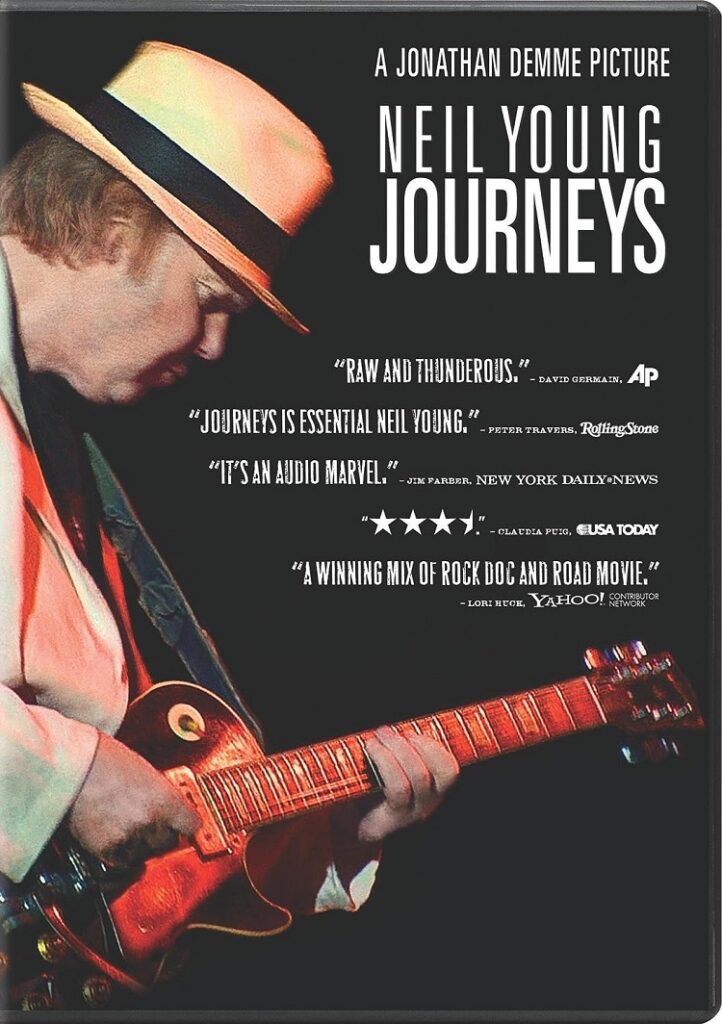
Neil Young Journeys is director Jonathan Demme’s third film starring the musician, the previous two being Neil Young: Heart of Gold and Neil Young Trunk Show. Journeys is predominantly a concert film recorded at Toronto’s Massey Hall where Young performed solo two nights in support of Le Noise. In addition, Demme shot footage of Young driving to the show behind his brother Bob from their hometown Omemee. He describes it as “a town in North Ontario,” bringing to mind his song “Helpless,” which plays over the closing credits.. Along the way, Young reminisces about growing up, giving the film the feeling of a biography or memoir.
The first song Young performs is “Peaceful Valley Blvd.” He plays an acoustic guitar that is augmented by a great deep echo and vibrations. Demme makes use of just a few different camera shots: straight ahead, close-up at an angle, and a crane shot. Right from the start, it certainly doesn’t bring to mind the inventiveness expected by the director of Stop Making Sense.
Young plugs in for “Ohio.” and even without a band behind him, the song has great power. Archival footage from Kent State is intercut and the names of the “four dead in O-Hi-O” (Alison Beth Krause, Jeffrey Glenn Miller, Sandra Lee Scheuer, William Knox Schroeder) are listed followed by their pictures being shown.
Demme makes an odd choice during “Down By the River” of using a lipstick camera attached to the mike, resulting in the lower half of his face dominating the shot. Young gets a great sound on the electric guitar. The lipstick camera returns during “Hitchhiker’ and gets either spit or sweat on it, but the more interesting image was the brief split screen of Young playing guitar. In between new songs “Love and War,” which he plays on acoustic guitar, and “Leia,” where he moves to keyboards, Young wanders around an area and talks about camping out in a tent near his home as a kid.
The concert is the marvelous performance expected from Young. The driving material rambles a bit and while delivering interesting anecdotes about Young, it doesn’t really blend with the songs they lead into. During future viewing, I will skip to the concert segments and not watch the rest.
The video has been given a 1080p/MPEG-4 AVC encoded transfer displayed at an aspect ratio of 1.78:1. The colored lights during the concert come through in solid hues, and colors naturally appear brighter during the daytime exteriors. Similarly, the details were soft during the concert and came into sharper focus during the exteriors. The blacks are light during the show and grain can be seen, especially the footage of the audience during “You Never Call,” which had so much grain it looked like it was shot on 16 mm.
The audio option is available as DTS-HD Master Audio 5.1. Young’s playing fills the surrounds with great power. The track presents a wide dynamic range with a demonstrative bottom end when bass and distortion are important element to the arrangement. His vocals are mixed well with the music and never get lost.
Paul Rachman moderates “Journey to Slamdance: A Conversation with Neil Young & Jonathan Demme” (HD, 36 min) as the two discuss working together and their creative processes. The latter of which is further explored through questions from the audience. “92Y Talks with Neil Young and Jonathan Demme” (HD, 34 min) is another joint interview in support of the project and they cover some of the same information. “Making Journeys” (HD, 7 min) is a brief featurette that can be skipped if the other two features have been looked at. There is also the Theatrical Trailer (HD, 2 min).
Neil Young Journeys is a welcome addition to Young’s concert filmography and a great snapshot of the artist on tour in 2011 as the setlist featured a mix of classic songs and tracks from Le Noise.